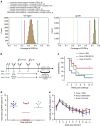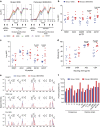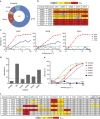Pentavalent HIV-1 vaccine protects against simian-human immunodeficiency virus challenge
- PMID: 28593989
- PMCID: PMC5472724
- DOI: 10.1038/ncomms15711
Pentavalent HIV-1 vaccine protects against simian-human immunodeficiency virus challenge
Abstract
The RV144 Thai trial HIV-1 vaccine of recombinant poxvirus (ALVAC) and recombinant HIV-1 gp120 subtype B/subtype E (B/E) proteins demonstrated 31% vaccine efficacy. Here we design an ALVAC/Pentavalent B/E/E/E/E vaccine to increase the diversity of gp120 motifs in the immunogen to elicit a broader antibody response and enhance protection. We find that immunization of rhesus macaques with the pentavalent vaccine results in protection of 55% of pentavalent-vaccine-immunized macaques from simian-human immunodeficiency virus (SHIV) challenge. Systems serology of the antibody responses identifies plasma antibody binding to HIV-infected cells, peak ADCC antibody titres, NK cell-mediated ADCC and antibody-mediated activation of MIP-1β in NK cells as the four immunological parameters that best predict decreased infection risk that are improved by the pentavalent vaccine. Thus inclusion of additional gp120 immunogens to a pox-prime/protein boost regimen can augment antibody responses and enhance protection from a SHIV challenge in rhesus macaques.
Conflict of interest statement
S.P. and J.T. are employees of Sanofi Pasteur. B.T.K. and B.F.H. have patent applications submitted on vaccine candidates used in this study. The remaining authors declare no competing financial interests.
Figures






Similar articles
-
Evaluation of immune responses induced by HIV-1 gp120 in rhesus macaques: effect of vaccination on challenge with pathogenic strains of homologous and heterologous simian human immunodeficiency viruses.Virology. 2000 Aug 15;274(1):149-64. doi: 10.1006/viro.2000.0444. Virology. 2000. PMID: 10936096
-
A Trimeric HIV-1 Envelope gp120 Immunogen Induces Potent and Broad Anti-V1V2 Loop Antibodies against HIV-1 in Rabbits and Rhesus Macaques.J Virol. 2018 Feb 12;92(5):e01796-17. doi: 10.1128/JVI.01796-17. Print 2018 Mar 1. J Virol. 2018. PMID: 29237847 Free PMC article.
-
Rationally Designed Vaccines Targeting the V2 Region of HIV-1 gp120 Induce a Focused, Cross-Clade-Reactive, Biologically Functional Antibody Response.J Virol. 2016 Nov 28;90(24):10993-11006. doi: 10.1128/JVI.01403-16. Print 2016 Dec 15. J Virol. 2016. PMID: 27630234 Free PMC article.
-
Protection of neonatal macaques against experimental SHIV infection by human neutralizing monoclonal antibodies.Transfus Clin Biol. 2001 Aug;8(4):350-8. doi: 10.1016/s1246-7820(01)00187-2. Transfus Clin Biol. 2001. PMID: 11642027 Review.
-
GP120: target for neutralizing HIV-1 antibodies.Annu Rev Immunol. 2006;24:739-69. doi: 10.1146/annurev.immunol.24.021605.090557. Annu Rev Immunol. 2006. PMID: 16551265 Review.
Cited by
-
Antibody-Dependent Cellular Phagocytosis of HIV-1-Infected Cells Is Efficiently Triggered by IgA Targeting HIV-1 Envelope Subunit gp41.Front Immunol. 2020 Jun 9;11:1141. doi: 10.3389/fimmu.2020.01141. eCollection 2020. Front Immunol. 2020. PMID: 32582208 Free PMC article.
-
Adjuvanted HIV-1 vaccine promotes antibody-dependent phagocytic responses and protects against heterologous SHIV challenge.PLoS Pathog. 2020 Sep 3;16(9):e1008764. doi: 10.1371/journal.ppat.1008764. eCollection 2020 Sep. PLoS Pathog. 2020. PMID: 32881968 Free PMC article. Clinical Trial.
-
HIV/AIDS Vaccines: 2018.Clin Pharmacol Ther. 2018 Dec;104(6):1062-1073. doi: 10.1002/cpt.1208. Epub 2018 Oct 9. Clin Pharmacol Ther. 2018. PMID: 30099743 Free PMC article. Review.
-
Coadministration of CH31 Broadly Neutralizing Antibody Does Not Affect Development of Vaccine-Induced Anti-HIV-1 Envelope Antibody Responses in Infant Rhesus Macaques.J Virol. 2019 Feb 19;93(5):e01783-18. doi: 10.1128/JVI.01783-18. Print 2019 Mar 1. J Virol. 2019. PMID: 30541851 Free PMC article.
-
Vaccine-Induced Antibodies Mediate Higher Antibody-Dependent Cellular Cytotoxicity After Interleukin-15 Pretreatment of Natural Killer Effector Cells.Front Immunol. 2019 Nov 27;10:2741. doi: 10.3389/fimmu.2019.02741. eCollection 2019. Front Immunol. 2019. PMID: 31827470 Free PMC article. Clinical Trial.
References
-
- Rerks-Ngarm S. et al.. Vaccination with ALVAC and AIDSVAX to prevent HIV-1 infection in Thailand. N. Engl. J. Med. 361, 2209–2220 (2009). - PubMed
-
- Flynn N. M. et al.. Placebo-controlled phase 3 trial of a recombinant glycoprotein 120 vaccine to prevent HIV-1 infection. J. Infect. Dis. 191, 654–665 (2005). - PubMed
-
- Pitisuttithum P. et al.. Randomized, double-blind, placebo-controlled efficacy trial of a bivalent recombinant glycoprotein 120 HIV-1 vaccine among injection drug users in Bangkok, Thailand. J. Infect. Dis. 194, 1661–1671 (2006). - PubMed
Publication types
MeSH terms
Substances
Grants and funding
LinkOut - more resources
Full Text Sources
Other Literature Sources

